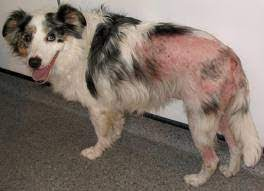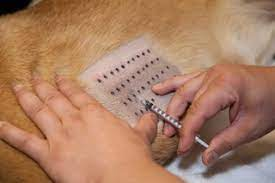Just like people, cats and dogs can get allergies, too. They can be broken down into environmental allergies, food allergies and allergies to flea bites, which is especially common in an area like Houston.

Unlike people, companion animals tend to manifest allergies in their skin – basically they start to itch. Sometimes they get runny eyes and noses the way people do but the majority start chewing on themselves or lick excessively.
For seasonal allergies, different regions can cause more dramatic symptoms. Hot humid areas with high pollen counts (Houston is one of these spots) is often worse than cooler, less humid climates as found in the Midwest and Northeast.
Animals with food allergies can be found anywhere. The same can be said of flea bite allergies but the prevalence of fleas is found in certain areas more than others.

What owners typically see:
- Hives
- Licking/chewing paws, trunk, legs, facial rubbing
- Loss of fur
- Scabs and very red skin
The distribution of skin lesions can be helpful in pinpointing the problem:

- Environmental allergies or food allergies are generally all over the body
- Flea bite dermatitis is often seen where fleas like to hang out – the rump, tail and back legs
- Contact dermatitis – allergies to what your pet is walking on is typically seen on the paws and underside, regions that have contact with the insulting surface
Sometimes these issues overlap and it is hard to know what the inciting cause is. The first thing your veterinarian should want to do is remove any possible issues that are contributing. Your veterinarian may make sure a good flea medication is being given monthly. Even if fleas are not seen, to the allergic pet, one bite is all it takes to drive them crazy
Looking microscopically at areas that are affected called cytology may also be recommended. Scabs can be lifted and the ooze underneath picked up on microscope slides that can be evaluated.For more complicated issues skin biopsies and even cultures may be warranted.
Cats and dogs with environmental allergies and flea bite allergies often respond to certain medications. They typically do not respond to food allergies. So failure to respond to veterinary prescription allergy medications may give your family veterinarian clues if food allergies are present.
If so, there are special hypo-allergenic diets that can be tried. Don’t confuse that with grain-free diets which have an association with heart disease.
As a side note, grain-free diets haven’t shown any benefit to cats and dogs with allergies and have been linked to a specific type of heart disease called dilated cardiomyopathy (DCM). Typically, it is the protein that causes the majority of the problems in animals with food allergies.
So, if a food allergy is suspected, work with your veterinarian on finding an appropriate diet. It should also be noted that only a small percentage of patients with allergies, about 12-15%, have food allergies as the cause of their issues.
Treatment for Flea and environmental allergies
Over the last several years, several new products have become available to manage allergies without the side effects associated with older medications such as steroids. While use is off-label for cats, there are off-label (non-FDA approved) options for cats that have approval for dogs.
Additionally, for both cats and dogs allergy testing by serum (the non-cellular portion of blood) or intra-dermal testing (similar to what’s done in people) are available and oral allergy immuno-therapy formulations are available through a variety of laboratories and pharmacies that make up custom treatment vials for a specific pet’s allergy profile.

If your companion animal is scratching or chewing at his or herself throughout the day and seems uncomfortable, bring them in to see your family veterinarian. Today there are many options to help your cat or dog live more comfortable lives!


